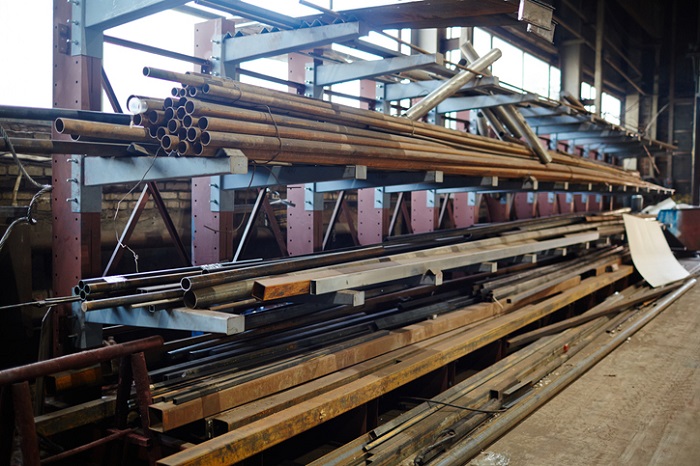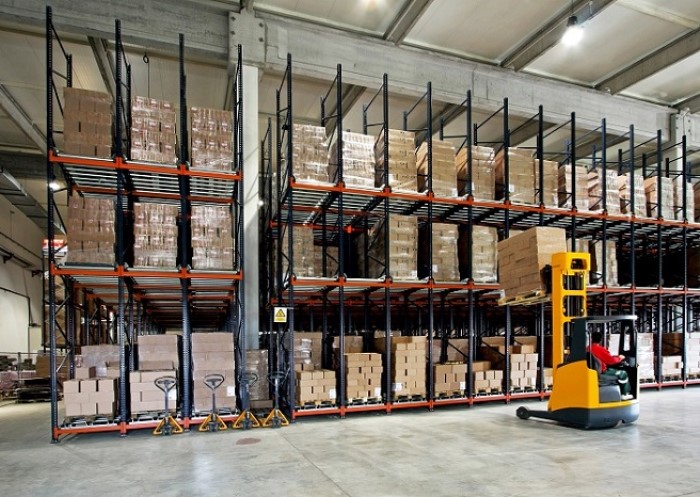Table of contents
Pallet racks offer many advantages for storage and workspaces. Vertical racking allows for optimal use of floor space and can be adapted to your requirements. Pallet racks also support automated loading and unloading of goods, making picking and inventory control much easier.
However, as with all other storage equipment, pallet racking must meet certain regulations to protect both employees and equipment, as well as the racking itself, from damage and accidents. As a result, the specifications laid out in the pallet rack assembly instructions and operating guides for pallet racks must be observed. In addition, trade associations and the Health and Safety Executive (HSE) have drawn up regulations for the safe assembly and operation of pallet racks, which must be followed. The use of work equipment such as pallets is also covered by the Provision and Use of Work Equipment Regulations 1998 (PUWER).
It’s important to note that while most racking guidance is not legally binding, following it helps meet safety requirements and avoid potential fines. The Storage Equipment Manufacturers’ Association (SEMA) provides industry-specific guidelines and codes of practice that are widely recognised in the UK.
In this guide, we explain the most important pallet racking regulations so that you can use these versatile storage systems safely in your business.
Pallet racking regulations – protective measures for storage racks
Pallet racks can carry bay loads of up to 9 tonnes for standard frames, medium duty frames up to 15 tonnes, and heavy duty up to 20 tonnes, dependent on the heights and depths of the frames. Due to this large load capacity, pallet racking poses a certain amount of danger. If racks are not properly constructed or have defects, collapse or overturning can occur and lead to potentially fatal accidents in warehouses and storage areas. The likelihood of such serious accidents is even higher when forklift or pallet trucks are on the move in the racking aisles.
As a result, pallet racks are subject to regular inspection. Company owners or warehouse operators must take measures to comply with the pallet racking regulations, within the framework of a risk assessment. The HSE has summarised the detailed regulations for the safe assembly and operation of pallet racks in Warehousing and storage: A guide to health and safety HSG76.
A programme of installation training is offered by Storage Equipment Installers Registration Scheme (SEIRS). This is run by SEMA and there is more information on their website. SEMA also runs the SEMA Approved Racking Inspector (SARI) scheme, which qualifies experts to conduct thorough annual inspections.
Regulations on the standing area for pallet racks
To ensure that pallet rack assembly occurs safely and is correctly aligned, it is important to have a suitable base in place. This is particularly true if large loads are to be accommodated in the racks. For this purpose, the subfloor must be suitable to support the rack up to and including the maximum load. Furthermore, the subfloor must be level enough to allow the pallet rack to be erected exactly vertically. In addition, the subfloor must be suitable for the obligatory anchoring of the pallet rack to the floor.
Correct erection of pallet racks
Pallet racks assembly must take place in accordance with the assembly instructions and may only be joined together with suitable connecting parts. Depending on the type of pallet racking assembly, this is carried out using either a plug-in or bolted system, although a combination of both systems is often used for more stability. In addition, the cross members and cross beams of the pallet rack must be secured against lifting out. Double-sided runs should be connected and spaced using suitable run spacers.
Observe pallet rack aisle widths and distances
Depending on whether the pallet rack is used in a narrow-aisle or wide-aisle warehouse, the aisle widths specified in the pallet racking assembly instructions and the HSE specifications must be considered. These are based on the respective industrial trucks used in the aisles for order picking as well as the storage height. Aisles should be designed to be wide enough to ensure that mechanical handling equipment can be easily manoeuvred. Widths will also depend on the type of equipment used. For example, some require a 90° turn to load and offload, others remain parallel to the aisle and have forks at 90° to the direction of travel.
In addition, according to the regulations, the pallet racks may only be installed at a certain distance from the wall. This also requires the installation of spacers or overhangs.
Frame and clearance heights
For safe storage and retrieval of pallets, the regulations on frame heights must be observed. For example, frame heights should exceed the uppermost tie bar supports and for passageways, a rack height of at least 2 m is recommended. The clearance heights always depend on the dimensions of the forklift trucks used.
Regulation on fall and push-through protection for pallet racking
If the pallet rack has been suitably configured and assembled in accordance with the regulations, the installation of push-through safety devices is not mandatory. The purpose of these is to prevent stored goods from sliding through or falling off during storage. The safety devices only need to be used if the minimum distance between two pallets stored one behind the other in double racks is less than recommended.
Pallet racking regulation – Install ram-rail protection
If non-guided industrial trucks such as forklifts or lift trucks are used for loading and unloading stationary pallet racks, the racks must be equipped with devices for impact protection in passageways and at corners. Otherwise, collisions between the vehicle and the racking can occur, causing the racking to become damaged and unstable. Collision protection must be marked in a conspicuous colour.
In addition, the impact protection must be anchored to the ground. Pile-driving protection corners or pile-driving protection planks can be used here.
Calculate and observe the load capacity
When selecting and setting up pallet racks, it is imperative that the permissible load per bay and shelf is always considered so that the rack is not overloaded under any circumstances. The load capacity depends on the maximum weight of the pallets to be stored and their distribution on the pallet rack. The racks must also be visibly marked with the corresponding maximum values. You may be able to use a pallet rack load capacity calculator to ascertain the maximum load volumes.
Racking inspection and operating instructions
To ensure the long-term safety and stability of pallet racking, the storage equipment must be inspected regularly by suitably qualified personnel. These are people who have received specialist training in the safety and handling of pallet racking.
The frequency of inspections depends on several factors that are particular to the site. However, there should be a nominated ‘person responsible for racking safety’ (PRRS) to suit the operating conditions. Inspections should consider the frequency and method of operation together with the dimensions of the warehouse, the equipment used, and personnel involved. The inspection follows a hierarchical approach utilising several levels of inspection and a record should be kept of all pallet inspections.
HSE and SEMA recommend the following inspection regime:
- Immediate reporting: Employees should report any damage or safety concerns as soon as they are observed.
- Visual inspections: The PRRS should conduct weekly visual inspections and maintain a formal written record.
- Expert inspections: A technically competent person, such as a SARI, should conduct thorough inspections at intervals of no more than 12 months. A written report should be submitted to the PRRS with observations and proposals for any necessary remedial work.
Mandatory labelling for pallet racks
To ensure that pallet racks are not accidentally overloaded in daily operations, racking should have a clear unambiguous notice securely attached. This should state the maximum load together with any necessary specified load configurations, with information such as:
- Rack manufacturer or importer
- Rack type with frame and upright type
- Year of manufacture or commission number
- Maximum load capacity broken down into shelf load and bay load
- Maximum free buckling length
The regulations for pallet racks detailed here are only a selection of the most important specifications. Detailed information, dimensions and notes on the necessary safety equipment can be found in the listed HSE regulations. In case of doubt, experts or specialists for occupational safety should also be consulted before the installation and use of pallet racking.
Legal requirements and compliance
While most racking guidance is not legally binding, failure to implement required safety standards can result in significant fines. The HSE has the authority to impose penalties for non-compliance, which can reach substantial amounts.
For new warehouse constructions or major modifications, the Construction Design & Management (CDM) 2015 regulations may apply. These regulations place specific responsibilities on clients, designers, and contractors to ensure that health and safety is considered throughout the project lifecycle.
It’s also worth noting that specific standards like EN 15512 or SEMA Design Codes should be followed for racking design to ensure compliance with best practices and safety standards.
Please note: The regulations mentioned above represent only a selection of the most important legal requirements. Please refer to the listed organisations and directives for more detailed information. If in any doubt, consult experts or contact the relevant regulatory authorities.
Image source:
© gettyimages.de – Halfpoint
© gettyimages.de – Smederevac





